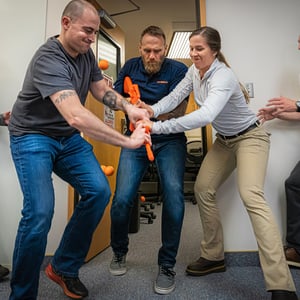Dangerous situations can arise anywhere, at any time. The majority of active shooter incidents happen at workplaces, schools and in open spaces like festivals and transportation areas. But they also take place at houses of worship and personal residences.
While it might not be something you want to think about, the threat of active violence is real. So, it’s important to prepare yourself to respond to situations of active violence.
Stay alert: Maintain situational awareness
By paying attention to your surroundings, you’ll have more time to plan and react quickly if something dangerous happens.
Follow these tips to help stay alert and increase your situational awareness.
-
Observe warning signs. Certain behaviors can forecast a person’s intent to do harm, such as sharing alarming content on social media or showing signs of escalating anger or aggressive or erratic behavior.
-
If you see something, say something. Report suspicious behavior to local authorities or appropriate personnel.
-
Have an exit plan. Always identify exits and areas to hide wherever you go. Ask yourself, “What would I do first if active violence occurs?”
Be ready to respond: Everyone reacts differently
When you’re under immediate duress, your body and mind will react in these different ways:
-
The immediate reaction is to get away quickly. And in many cases, running away is the best option. Move in an unpredictable way and avoid moving in large groups, if possible. Find cover for protection from bullets. When the shooting stops, move to cover further away from the attacker while taking steps to stay concealed away from the assailant’s line of sight.
-
The brain makes a split-second decision that fighting the assailant is the best option for survival. If you can’t escape your location, take steps to defend your space and distract the attacker to slow their violent progress. Build a barricade with anything available and gather objects to throw at the attacker. If you’ve chosen to fight, be proactive and aggressive. Work as a group to overwhelm the assailant and take control of any weapons.
-
A freeze response isn’t a conscious decision, but rather an involuntary physical, mental and emotional immobilization. If this happens, your first step is to break the freeze by moving and trying to escape your current location. If you see someone else is frozen, instruct them to “Move!”. If necessary, strike them forcefully in the back or shoulders and direct them to an evacuation route.
Until you experience an active violence event, you won’t know how you’re going to react. But you can still prepare and train, so that you can react more quickly and decisively.
Active Violence Emergency Response Training (AVERT)
 One of the best ways to prepare for an active violence incident is to receive training that provides realistic scenarios and hands-on practice for responding.
One of the best ways to prepare for an active violence incident is to receive training that provides realistic scenarios and hands-on practice for responding.
HSI’s AVERT program provides life-saving strategies to help you anticipate potential danger, react quickly if active violence occurs and become an immediate responder to life-threatening bleeding.
To learn specific techniques to escape, evade and attack during an active violence event and get training for your organization, contact an AVERT expert for more information
You can also become an authorized AVERT Instructor. Learn more here.







.png?width=600&name=HSI-CTA-EmergencyCareTraining%20(1).png)











Comments